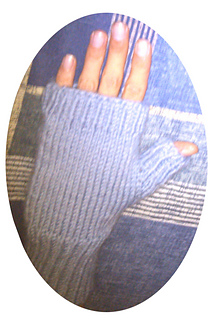patterns >  Katherine Doyle's Dropbox
Katherine Doyle's Dropbox
> Mitlets Fingerless Mittens



Mitlets Fingerless Mittens
Many people don’t enjoy using double-pointed needles to knit in the round. It is possible to knit tubes on straight needles by knitting only the stitches for one half at a time while slipping the stitches for the other half.
I use a cable needle, or dpn as a cable needle, to work increases and decreases. I move the unused stitches out of the way, increase, and then return the stitches to the proper place on the needle. It may sound a little complicated, but if you knit using the Continental method, the yarn is moved front to back as needed without any fuss.
A gap can form at the edge if you don’t snug up the first knit stitch. The second stitch is usually slipped, and you should insert the needle into the stitch about to be slipped before you tug the yarn to snug up the first stitch. It is easier to insert the needle into the first slipped stitch on a row when working in stockinette than when working in ribbing.
Don’t forget to check every few rows to make sure that your tube doesn’t have any crossed stitches. Stitches that get crossed from one part of the tube to the other will make it impossible to put on your Mitlets after they are completed. It is easier to “un-knit” a couple of rows than it is to pull out a large section and then get everything back on the needles properly. Crossed stitches can happen if you purl a slipped stitch instead of just slipping it from needle to needle.
There are many tutorials on YouTube.com that demonstrate double-knitting techniques. Most produce a flat fabric, but can be useful for knitting tubes.
109093 projects
stashed
32065 times
3489 projects
stashed
2917 times
699 projects
stashed
467 times
- First published: January 2011
- Page created: October 30, 2012
- Last updated: August 20, 2024 …
- visits in the last 24 hours
- visitors right now

